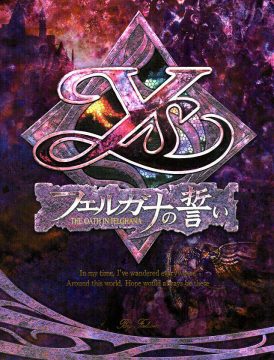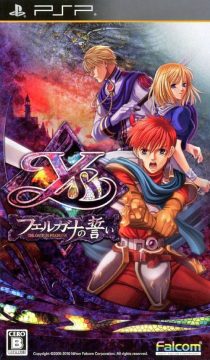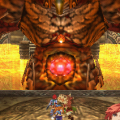- Ys Book I & II
- Ys III: Wanderers from Ys
- Ys IV: Dawn of Ys / Mask of the Sun
- Ys V: Ushinawareta Suna no Miyako Kefin
- Ys VI: The Ark of Napishtim
- Ys: The Oath in Felghana
- Ys Origin
- Ys Seven
- Ys: Memories of Celceta
- Ys VIII: Lacrimosa of Dana
- Lacrimosa of Dana (Novel)
- Ys IX: Monstrum Nox
- Ys X: Nordics
- Ys Strategy
- Ys: The Call of Solum
- Ys vs. Sora no Kiseki: Alternative Saga
- Ys (Anime)
Ys III was often regarded as a bastard child of the series for moving to the side-scrolling perspective. Aware of the fans complains, Falcom decided to remake the game using the Ys VI engine and entirely remodel it in the process. Essentially, The Oath in Felghana retells the story of Adol journey to Dogi’s home village of Redmont, and his entangling with the darling Elena and her insidious brother Chester. While the basic plot is exactly the same, it’s fleshed out much more to make it fit in better with the world of Ys. The townspeople are given more personality and purpose, and there’s quite a bit more dialogue.
There are minor changes here and there, naturally – Adol begins the adventure by protecting Elena from a pack of wolves, as opposed to simply strolling into town. You actually get to fight Chester before he throws you into the volcano pit. And instead of merely stumbling upon Bob’s pendant in the Tigray Quarry, it can be seen early on, lying across a ravine that can’t be crossed until later in the game. The map screen is gone too, replaced by a small overworld. The dungeons are now much longer and more intricate, although they’re still based on their original designs. Areas that were merely a few screens before have been expanded into huge, multi-tiered mazes. Because of this expansion, The Oath in Felghana is easily three times longer than the original. In spite of all of these changes, it still remains faithful to its source, as the structure is pretty much the same as Ys III.
The gameplay has been polished up a bit since Ys VI. Adol’s sword combo is longer, and attacking enemies in mid-air is a bit easier. The enemies are no longer as aggravating and flash briefly before attacking. About halfway through the game, you get a double jump, as well as the ability to warp between save points, which eliminates a lot of annoying backtracking. As you attack enemies, you build up a Burst meter. This, when activated, gives Adol a significant power and speed boost for a limited time. The magic system is similar to the one in Ys II – you can throw fireballs or attack with whirlwind slashes, and the magic meter regenerates quickly. Spells are activated through the use of bracelets, which replace the Rings from Wanderers from Ys.
Equipment can be upgraded by the use of crystals, but they can only be found hidden in treasure chests (at least, until late in the game), which provides an incentive to explore every nook and cranny of each level. A new chaining system increases experience as long as you keep hacking up enemies, and bad guys now drop a variety of power-ups to temporarily increase strength, magic, or health. The downside to this is that Adol can no longer carry healing items and regenerate life at will. This makes the boss battles far more difficult than before, since you have extra health to fall back on. Overall, the game does lean on the tough side, but there’s an easy level for beginners, which will even politely restart you on the same screen if you fall down a pit, instead of sending you down to a different part of the stage.
The graphics haven’t really improved much since Ys VI, but they’re still decent. While there’s no voicework in the PC version, the biggest star is the rearranged soundtrack. Ys III had what was almost universally considered the best soundtrack of the series, and many felt it would be hard to top the majesty of the TurboGrafx-16 redbook soundtrack. And yet The Oath in Felghana somehow succeeds in besting not only every other arrangement of the Ys IIIsoundtrack, but every other game in the series. And unlike the synth-heavy Ys VI soundtrack, the musicians use real instruments, and the blaring rock anthems of the Tigray Quarry or the various boss battles sound mighty awesome when played on an electric guitar.
The only real thing that can be held against The Oath in Felghana is that it’s not a totally new experience – it’s better than any incarnation of Ys III in every possible way (and even a step up from Ys VI), but it still feels as if Falcom could have used the resources for a completely new game. Still, when the rest of the package is as good as this, it’s hard to fault it too much, and it’s not going to make a difference for the huge amount of people who’ve never played Ys III before. The initial PC release of Ys: The Oath in Felghana contains a 7 CD box set with almost all of the music available for Ys III, although it’s lacking any of the console versions. A fan translation was released by Deuce and Nightwolve.
In 2010, The Oath in Felghana was released on the PSP. While the port of Ys VI, done by Konami, was somewhat questionable, Falcom handled this port themselves, and it is substantially better on a technical level. The framerate is smooth, though it tops out at 30 FPS as opposed to the 60 FPS of the PC version. The load times are brief, and the sound quality is excellent. While the resolution is obviously lower, it still looks pretty decent, and the camera has been zoomed out appropriately. It includes some options later patched into the PC version, like the easier difficulty levels, and the ability to restart a screen after falling down a pit, instead of dropping into a different part of the dungeon. If you die in a boss fight, you can also choose to restart it at a lower difficulty.
The Burst meter has been modified to allow two meters – when activated twice, Adol is even more powerful, and can regenerate health when attacking enemies, which is especially useful for turning the tides in boss battles. Like the PSP port of Ys Chronicles, there are options for three different types of soundtracks from other versions of Ys III – in addition to the arranged version in the original PC release of Felghana, you can also pick the soundtrack from the PC-88 version or the X68000 version. (The TurboGrafx-16 remixes, unfortunately, are unavailable, since the port was published by Hudson rather than Falcom.) It also adds in full voice acting. This PSP port was published in English in 2010, using a revised version of Deuce’s translation. The quality of the voice acting varies, but most of it is quite good, especially the stately narrator who announces Adol’s actions. The limited edition release comes with a soundtrack CD and a small calendar.
This same translation was used in the English PC release, published on Steam. It’s the same as the original PC version, so it’s missing the niceties of the PSP release, but it does incorporate widescreen resolutions. There are also the usual mobile phone treatments released in Asian territories.
Screenshot Comparisons
Mobile Screenshots



